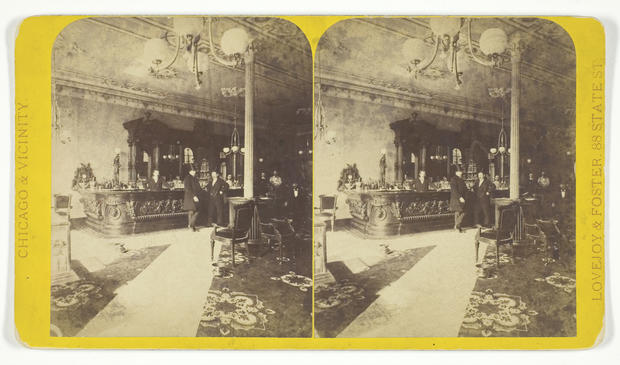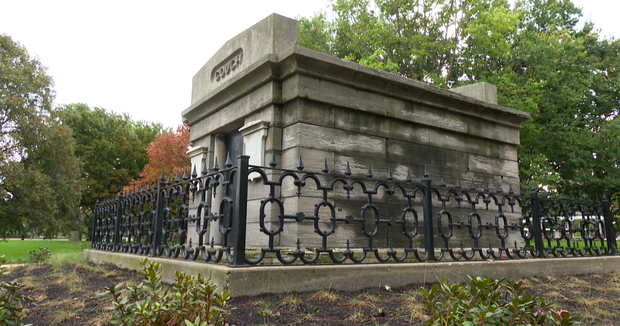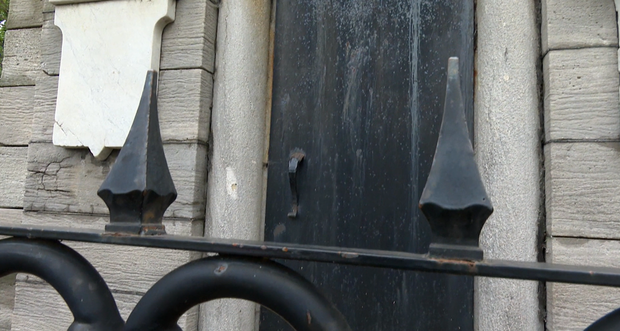Chicago Hauntings: The Mysteries Of The Couch Mausoleum In Lincoln Park And Who, If Anyone, Is Entombed There
CHICAGO (CBS) -- At the south end of Lincoln Park near the Chicago History Museum, you may have noticed a mausoleum with the name "Couch" carved at the top.
The Couch tomb is the only visible remnant left over from the days when the south end of the picturesque park – where today we also find the Lincoln Park Zoo – was the original city cemetery. As the Encyclopedia of Chicago tells us, the cemetery opened around 1843 and ceased burials in 1866 – after which the park was developed and named for assassinated President Abraham Lincoln.
The reason the cemetery was closed, Tony Szabelski of Chicago Hauntings Ghost Tours points out, had to do with poor sanitary conditions. Caskets were buried near marsh lands, and would wash ashore when the lake levels rose. The decomposed remains also contaminated drinking water – causing several cholera outbreaks.
But the Couch tomb remains. It memorializes businessman Ira Couch, who was on vacation in Cuba in the winter of 1857 when he died. He was only 50 at the time.
In a 2004 Gapers Block article, Chicago librarian Alice Maggio reported that Ira Couch and his older brother, James, likely arrived in Chicago in the early 1830s. Some accounts indicated that Ira Couch was a tailor and haberdasher by profession, Maggio wrote, but he became the proprietor of the celebrated and fashionable Tremont House Hotel at Lake and Dearborn streets in the Theatre District downtown.
The first Tremont House Hotel – a three-story wooden building on the northwest corner of the intersection – opened in 1833, but burned down six years later. The second hotel was built diagonally across the street and also burned down.
The third Tremont House Hotel was the one that became famous, as the Chicago History Museum points out. It was a five-story brick building with 260 rooms, designed by celebrated architect John M. Van Odsel.
The Tremont House was a favorite hotel for Abraham Lincoln to stay in, and he gave a version of his "House Divided" speech from the balcony. Stephen A. Douglas – the incumbent U.S. Senator whom Lincoln challenged and famously debated in the famous senatorial election of 1858 – also regularly stayed at the hotel in Chicago, and died there on June 3, 1861.
Lincoln's assassin, John Wilkes Booth, was also a guest at the hotel at one point.
The third Tremont House Hotel ended up meeting the same fate as the first two – it was destroyed in the Great Chicago Fire of 1871. But as noted above, Ira Couch died 14 years before that.
After Couch died in Cuba, his body was returned to Chicago for a wake and funeral, and was then placed in a holding vault in the city cemetery. His brother, James, had the mausoleum commissioned one year later in 1858, at a cost of $7,000 – a lot of money in those days. To put it in perspective, they were building houses for less back then.
Limestone was hauled all the way from Lockport, New York north of Buffalo to build the tomb.
But a lot of mystery surrounds the mausoleum to this day. First, it is not clear why it was left behind when the cemetery was removed.
"It is not entirely clear as to why the Couch Tomb was left behind," the Chicago Park District tells us. "It seems likely; however, that surviving family members thought it too expensive to move the fifty-ton structure to another cemetery. By 1899, the Lincoln Park Commissioners asserted that '…it would be impossible to remove the vault, except at great expense, and the Commissioners preferred to allow it to remain as an interesting reminder of the Park's origin.'"
But there were other mausoleums in the cemetery at one point, and they're all long gone.
What we also don't know is if anything actually remains inside the Couch mausoleum. It has not been opened – at least as far as records Chicago Hauntings could find – since the early 20th century.
There was a man who went inside when the park opened it to do some work around it. Some newspaper articles at the time reported that when the man went in, he claimed he saw nothing inside at all.
Couch's grandson saw those articles, and said that was not correct. He said there should be about seven people buried in the tomb – including Ira, his wife, his parents, two of his brothers who died young, and an unknown woman who died in the Tremont House Hotel.
But even more mysteriously, most of the names that the grandson mentioned as being entombed in the mausoleum have headstones elsewhere – on the family plot at Rosehill Cemetery miles farther north. Even Ira Couch himself has a headstone there.
But furthering the mystery even more, Ira Couch and his wife are not listed anywhere in Rosehill's records. So we really have no idea where they are. They could be in the mausoleum. They could be at Rosehill. We just don't know.
But ah, you came to read about ghosts, right? Well, Szabelski points out that some of the earliest ghost stories from Lincoln Park centered right around the Couch mausoleum.
As early as the 1880s, newspapers were reporting a local urban legend around the neighborhood. It claimed that if you came to the mausoleum at the stroke of midnight any night of the week, faced it looking up at the name Couch, and said thrice, "The graves belong to the dead, not the living," the doors would open and a big white ghost would come out and greet you.
A lot of people also reported seeing that big white ghostly figure around the mausoleum back in the 1880s too.
For more on the Couch mausoleum and all the mysteries surrounding it, take a look at Pamela Bannos' "Hidden Truths" project for Northwestern University.
Video produced by Blake Tyson. Written story by Adam Harrington.







